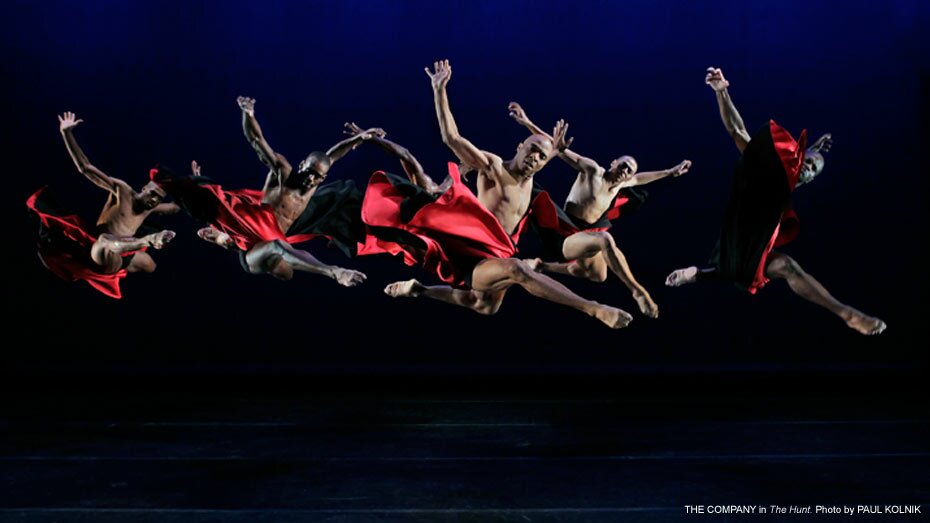Alvin Ailey American Dance Theatre kicked off the first of three performances presented by Seattle Theatre Group (tickets here for two remaining shows at the 5th Avenue Theatre for Saturday, 3/26 and Sunday, 3/27). Reading over some of my recent reviews, I realize that I use the word “thrilling” too much. And watching last night’s performance, I realize that I have I have been misusing the word. I now know what “thrilling” really means.
The tour is a celebration of the company’s rich history (the 50th anniversary of AAADT’s iconic work, Revelations), current success (the farewell tour for their iconic Artistic Director, Judith Jamison), and its future (the introduction of Artistic Director-Designate, Robert Battle). The show ended with an outstanding performance of Revelations, but it kicked off with three contemporary pieces–two of which literally left me breathless.
Anointed, by former company member Christopher Huggins, began with “Passing.” Principals Jamar Roberts in copper and Linda Celeste Sims in black entwine in a loving pas de deux to the slow synth-string swells of “Grace” by Moby. Their movements are fast, then slow, playing against the steady waves of strings. Sims exits the stage (perhaps alluding to the title of this section), leaving Roberts in a tormented solo. The next section, “Sally Forth,” sees Sims returning, now in purple, to the driving drums of “Blessed Love” by Sean Clements. She is joined by four other women who circle around her, their movements blending the low-to-the-ground, knees-bent posture of African dance with the hands-above-the head port de bras of classical ballet. Their strikingly deliberate movements combined with the power of the drums hits you with such force, I could only think, “whoa.”
The final section, 52 and Counting, opens with Roberts, now in brilliant white, with dancers in orange joining him in couples to “God Moving Over the Face of the Waters,” again by Moby. The men exit as Roberts now joins four women, becoming their center. Then five men take the stage alone. The power these men brought to the stage, their commanding power, was stunning. It had the raw speed of a roller coaster, and I felt like I could only hang on. When Roberts and Sims are reunited on the stage, they are joined by a dancer in orange before the lights go black.
The dancing in this piece was technically spot-on, but with passion and feeling that you just don’t get to see every day, even in the best dance companies. As a former AAADT dancer, Huggins clearly knew what these dancers were capable of and how to play to their considerable strengths. As my notes said, “insanely good.”
The next piece, The Evolution of a Secured Feminine, by Camille A. Brown, featured solo dancer Rachael McLaren. The piece features music sung by Ella Fitzgerald, Betty Carter, and Nancy Wilson. Fittingly, McLaren enters wearing a fedora and half a jacket (on the right, with a tube top on the left). Her moves are a blend of Michael Jackson and Usher (as she brushes off her shoulders), ballet and jazz. In dancing to “Tight” sung by Betty Carter, McLaren seems to show us the inner thoughts of the singer, revealing what her lyrics are masking. For the final section, to Nancy Wilson’s “Guess Who I Saw Today,” McLaren, in just a few minutes, takes her character from defeat over discovering her lover’s infidelity to owning her own power, as she holds out her hand, fingers open, to let him go.
Also now my new definition of thrilling was The Hunt, by AAADT Artistic Director-Designate Robert Battle. Les Tambours du Bronx, a French industrial percussion band, provides the music for this incredibly powerful (there is no other way to describe it) piece. Six men, shirtless with high-waisted black skirts that flow to the ground, break off into two groups of three, in rows battling, in a circle with their shoulders arching forward rhythmically to the throbbing drums. At one point, three of them literally drag the other three across the stage. A successful hunt? The drums had both a tribal feel but also echos of taiko. The skirts worn by the men, with red interiors to highlight their vulnerability, also lended to the Asian feel. They were like bad-ass Shaolin monks at times.
Even in skirts, you can’t imagine anything more masculine. Seriously, you can’t. I wanted to run over to the Paramount, grab Billy Elliot‘s father and brother, drag them over to the 5th and dare them to make fun of those dancers. They were in-effing-credible.
A short film, “Celebrating Revelations at 50,” preceded the performance of that work. Featuring interviews with Ailey and Jamison, it gave some context to what was to come. There isn’t much I can say that hasn’t already been said about Revelations. It’s iconic and will hold a special place in the cannon of American Dance, probably forever. Small moments, little touches, were what stood out for me. Brief, rapid taps of Amos J. Machanic, Jr.’s hand anointed the head of Aisha Mitchell in “Fix Me, Jesus,” blessing her. The rapid, bee wing-like movement of the fans held by the women in “Sinner Man.” The earnest, repentant stance of Clifton Brown in “I Wanna Be Ready,” crouched on the stage, tentatively reaching out–then pulling back in fear of judgment. This piece deserves its permanence.
And the company completely–totally–deserved every last second of the thunderous ovation the audience gave them. And I have a new understanding of what thrilling really is.
